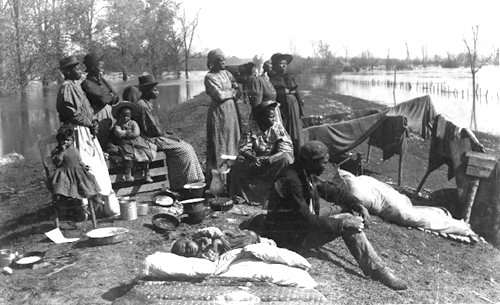The Colored Refugee Relief Board (originally called the Committee of Fifteen and then the Committee of Twenty-Five), was formed in St. Louis, Missouri in response to the Exoduster migration in March 1879. As thousands of destitute migrants arrived in St. Louis on their way to Kansas, the St. Louis African American community organized relief efforts. At the initial meeting, Charlton Tandy was elected president while John Johnson, John Wheeler, and Moses Dickson, all prominent members of the community, became members of the resolutions committee. As chairman of the relief committee, the board appointed the Reverend John Turner, minister of St. Paul’s, one of St. Louis’s most prominent African American churches. The relief board was empowered to collect donations to aid the Exodusters and to act on their behalf. Politically, the board asked the federal government to intervene in the South to improve the conditions for former slaves.
For months the board organized relief efforts for thousands of Exodusters. The board raised donations for food, clothing, and boat fare for the Exodusters, provided housing in churches and homes, and sent Tandy on speaking tours to publicize the conditions. Also, the board hired notaries to take affidavits from the Exodusters as testimony about conditions in the South. These affidavits were later presented to Congress by board leaders. During the month of April, 150 Exodusters a week were landing in St. Louis in need of help, and the board’s weekly expenses averaged nearly $800. By April 16, the board reported that more than 6,000 Exodusters had landed in St. Louis since the beginning of the movement; two thirds were destitute and needed help from the committee. By the end of May, 200 Exodusters were being sent to Kansas every Saturday by the board. A typical list of supplies provided by the board for the Exodusters’ trip to Kansas was 800 loaves of bread, 238 pounds of meat, and a barrel of corn meal.
The board was beset by controversy as some members of the local community questioned the board’s accounting practices. In particular, James Milton Turner, former member of the finance committee and prominent African American attorney and politician, accused the board of misusing funds. The board’s stance was that early on the urgency of the need for relief had necessitated quick action but that all money was accounted for. Turner eventually formed his own organization, a for-profit venture called the Colored Immigrant Aid Society, to compete with the Colored Refugee Relief Board. Turner’s organization was unsuccessful, and the Colored Refugee Relief Board remained the primary organization for providing Exoduster relief. The relief board continued to provide relief to the Exodusters throughout 1879 and 1880, disbanding when the migration stopped.

